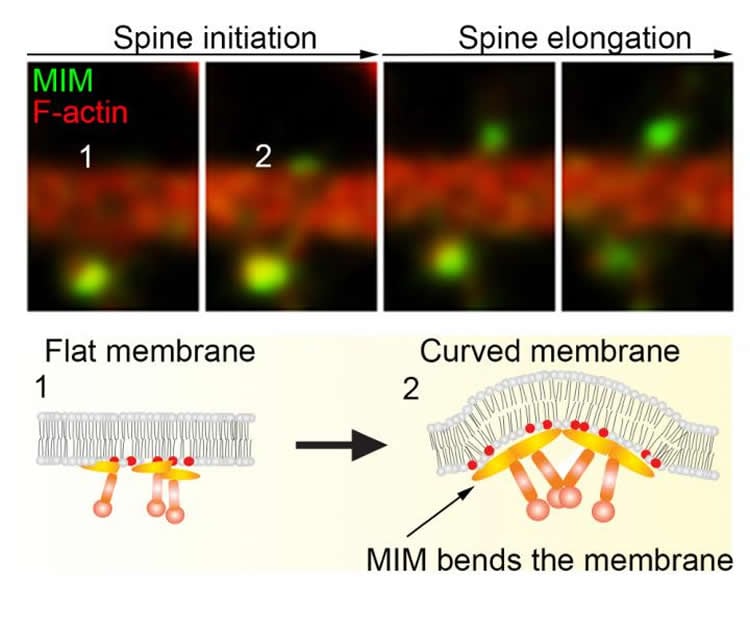Researchers from the University of Helsinki, ETH Zürich, Aix-Marseille and the German Mouse Clinic teamed up to investigate the initiation process of dendritic spines. They discovered that protein called MIM bends the plasma membrane to aid the formation of dendritic spines from the surface of the neuronal dendrite.
The discovery is important, as most of the neuronal connections, called synapses, are build to dendritic spines. In many central nervous system diseases, the dendritic spine density is altered.
“Understanding of the molecular mechanisms underlying the initiation process of dendritic spines enables us to manipulate their initiation rate and density. In future, this knowledge can be helpful in the development of therapeutic interventions for neurological diseases underlined by altered dendritic spine density, such as autism spectrum disorder, Schizophrenia or Alzheimer´s disease. Furthermore, this will help us to understand the molecular basis of learning, as new spines are readily initiated during learning,” says project leader Pirta Hotulainen from the Neuroscience Center of the University of Helsinki.

This research has been collaboration between many distinct research groups combining cell biology to neuroscience. “No sole research group could have achieved such a comprehensive view of the dendritic spine initiation mechanism and show its importance for the brain function,” says Pirta Hotulainen.
Source: Pirta Hotulainen – University of Helsinki
Image Credit: The image is credited to Pirta Hotulainen and Juha Saarikangas
Original Research: Abstract for “MIM-Induced Membrane Bending Promotes Dendritic Spine Initiation” by Juha Saarikangas, Nazim Kourdougli, Yosuke Senju, Genevieve Chazal, Mikael Segerstråle, Rimante Minkeviciene, Jaakko Kuurne, Pieta K. Mattila, Lillian Garrett, Sabine M. Hölter, Lore Becker, Ildikó Racz, Wolfgang Hans, Thomas Klopstock, Wolfgang Wurst, Andreas Zimmer, Helmut Fuchs, Valérie Gailus-Durner, Martin Hrabě de Angelis, Lotta von Ossowski, Tomi Taira, Pekka Lappalainen, Claudio Rivera, and Pirta Hotulainen in Developmental Cell. Published online June 4 2015 doi:10.1016/j.devcel.2015.04.014
Abstract
MIM-Induced Membrane Bending Promotes Dendritic Spine Initiation
Highlights
•MIM deforms plasma membrane into proto-protrusions that initiate spine formation
•PIP2 promotes MIM recruitment and subsequent Arp2/3-mediated actin assembly
•MIM deficiency decreases and overexpression of MIM increases spine density
•Loss of MIM in mice results in aberrant synaptic transmission and behavior
Summary
Proper morphogenesis of neuronal dendritic spines is essential for the formation of functional synaptic networks. However, it is not known how spines are initiated. Here, we identify the inverse-BAR (I-BAR) protein MIM/MTSS1 as a nucleator of dendritic spines. MIM accumulated to future spine initiation sites in a PIP2-dependent manner and deformed the plasma membrane outward into a proto-protrusion via its I-BAR domain. Unexpectedly, the initial protrusion formation did not involve actin polymerization. However, PIP2-dependent activation of Arp2/3-mediated actin assembly was required for protrusion elongation. Overexpression of MIM increased the density of dendritic protrusions and suppressed spine maturation. In contrast, MIM deficiency led to decreased density of dendritic protrusions and larger spine heads. Moreover, MIM-deficient mice displayed altered glutamatergic synaptic transmission and compatible behavioral defects. Collectively, our data identify an important morphogenetic pathway, which initiates spine protrusions by coupling phosphoinositide signaling, direct membrane bending, and actin assembly to ensure proper synaptogenesis.
“MIM-Induced Membrane Bending Promotes Dendritic Spine Initiation” by Juha Saarikangas, Nazim Kourdougli, Yosuke Senju, Genevieve Chazal, Mikael Segerstråle, Rimante Minkeviciene, Jaakko Kuurne, Pieta K. Mattila, Lillian Garrett, Sabine M. Hölter, Lore Becker, Ildikó Racz, Wolfgang Hans, Thomas Klopstock, Wolfgang Wurst, Andreas Zimmer, Helmut Fuchs, Valérie Gailus-Durner, Martin Hrabě de Angelis, Lotta von Ossowski, Tomi Taira, Pekka Lappalainen, Claudio Rivera, and Pirta Hotulainen in Developmental Cell. Published online June 4 2015 doi:10.1016/j.devcel.2015.04.014






